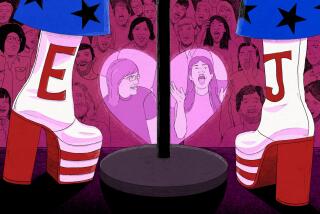The Authorized Version : How I Fell in Love With Jane
In 1971, the year they met onstage at an anti-war meeting, few could imagine as unlikely a pair as Tom Hayden and Jane Fonda. He was nationally known as a radical activist, a founder of the Students for a Democratic Society , and one of the most vocal critics of America’s involvement in the Vietnam War. She was a newcomer to the anti--war movement, the wife of French director Roger Vadim, and a Hollywood actress known for, among other roles, her portrayal of a sci--fi sex kitten in the film “Barbarella.” on screen as “Barbarella.”
Nothing really clicked at that first meeting. But a year later, when Fonda was making an anti-war speech and slide presentation at the Embassy Theater in Los Angeles , Hayden went backstage to offer a few pointers. There, they met for keeps; according to Hayden, Fonda sysa she knew then that they were destined to fall in love. What follows is the story of how this came about, excerpted from Hayden’s book, “Reunion : A Memoir, “ to be published later this month.
I WENT TO JANE’S Laurel Canyon house to show her my educational materials about Indochina. We sat on her living-room floor in front of the fireplace, and I flashed slide after slide on the opposite wall. Reflecting my emphasis on culture and people, the slides went through the little-known history of Vietnam, the villages, the importance of land, the people’s cultural modesty. Then it switched to the “Honda culture” of Saigon, the impoverished refugees, the brothels and bars full of teen-age prostitutes.
Jane was starting to cry. I kept flipping slides of grotesque young Saigon women, talking about the breast and eye operations performed to turn them into round-eyed, round-bodied, Westernized women, transforming them body and soul into creatures of our culture. Suddenly I understood why she was weeping: I was talking about the image of superficial sexiness she once promoted and was now trying to shake. I looked at her in a new way. Maybe I could love someone like this.
Jane was right. We did fall in love soon after. I was 32, she 34; both of us were starting over.
The passion of our common involvement no doubt caused our involvement in passion for each other. Being able to fight the same hazardous battles daily, and to do so together rather than in loneliness, was a powerful basis for this love. Work now took on a sheer enjoyment for the first time in years. Inner sources of love between two people cannot be fully analyzed; they are private and full of mystery. But it was important that Jane was a woman who could not be eclipsed or diminished in my shadow, and I was a man who was not threatened by her greater fame and power. She was fatigued by men who either pursued her as a notch on their belt or were rattled by being in her shadow. In addition, each of us reassured the other in fundamental ways: She wondered if she could be taken seriously, genuinely, as a committed person or whether she was a shallow latecomer to a decade-long movement; I wondered if there was any way to assert a public leadership role without damaging my personal relationships. We helped each other overcome these doubts.
Of course, there were other differences. She had missed the early years of the ‘60s, which were so important to my vision, patience and organizing approach. She had entered the movement at its most overheated state, when everyone and everything had hardened. In a very deep way I was still participating in the experience of youth, an outsider with no possessions or responsibilities, living by wits and ideals on the economic margin. She had dropped out of Vassar, gone straight into a successful career, become a mother, and amassed significant income, which was spent on her material desires. I could keep my clothes in one large drawer; she needed extensive closets and domestic help. I was a famous radical who was morally and politically skeptical about fame; she was an actress whose career itself depended on public acclaim. We must have appeared like a remake of “Beauty and the Beast,” but these differences were more amusing than stressful as we happily came to know each other that summer.
Not the least of the pleasures was getting to know her daughter, Vanessa, then 3, who was born at the time of Chicago, 1968, and had lived at the Blue Fairyland day-care center in Berkeley just after I left the city (Jane had been there filming “Steelyard Blues”); it seemed that Vanessa and I had been just missing each other at these key moments in our lives. The first night that Jane and I made love, Vanessa marched out of her bedroom, a 3-year-old inspector, and stared at me. I stared back, smiling; here I was starting over in yet another relationship with a young child not my own. Her father, Roger Vadim, seemed to be a loving and supportive parent, with children from several marriages scattered from Los Angeles to Paris, so I didn’t worry much about Vanessa finding her own way in life. Besides, after my shattered relationship with Christopher (the son of a former lover), I was very tentative about committing myself to someone else’s child.
Then, on a spring day in a New York hotel room, fresh from a trip to Vietnam, where she had seen women having children in the face of death, Jane was moved to create life as her answer to numb alienation. With a slight sigh, she stood behind me, naked, and whispered, “I want to have a child with you.” With a tearful smile, I said yes.
My answer was immediate, even though my feelings about having a family had oscillated between extremes. The breakup of my parents’ marriage after my father returned from the Marines had been an utter shock. When I married Casey (my first wife), the threat of war became my excuse to forswear having children. For several years the concept of children had simply been erased, or repressed, from my desires; in the same way, I had separated myself from all conventions of society. At one point in the mid-’60s, when an important woman in my life became pregnant, we immediately decided on an abortion, without emotion or debate, as if there were no other real choice. Then, as the polarization of society deepened, only survival seemed to matter. What I didn’t realize, until living with Christopher in Berkeley brought it home, was that I had smothered a longing that was volcanic. Jane’s simple words caused it to erupt.
This new infatuation with life seemed to embolden us toward a new commitment to ending the incessant war. In fact, rather than withdrawing into personal happiness, or sharply dividing private from public life, we decided that the only meaningful course was to hurl our personal relationship into the center of public life and resume anti-war work as a team, pregnant and all.
More to Read
The biggest entertainment stories
Get our big stories about Hollywood, film, television, music, arts, culture and more right in your inbox as soon as they publish.
You may occasionally receive promotional content from the Los Angeles Times.










